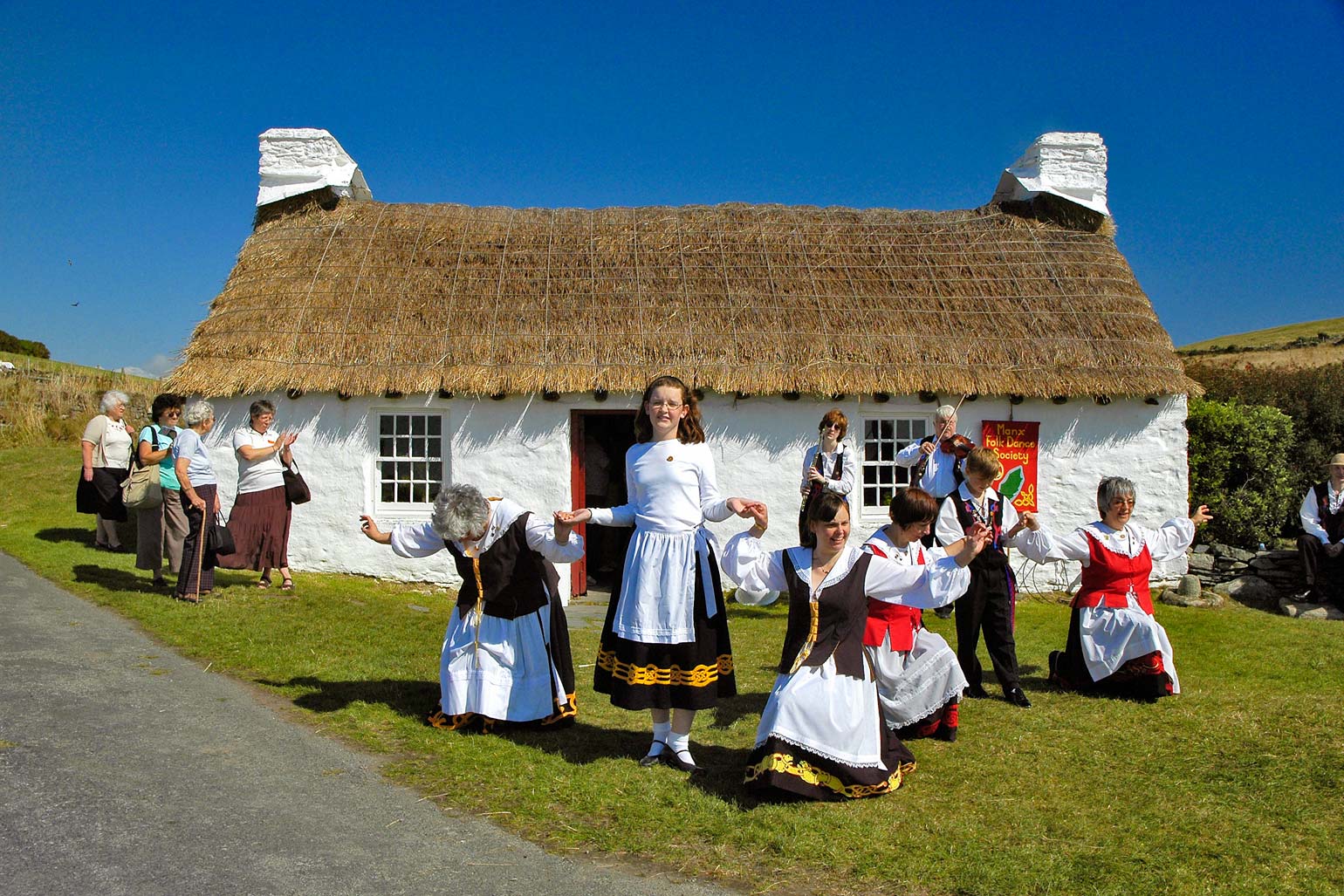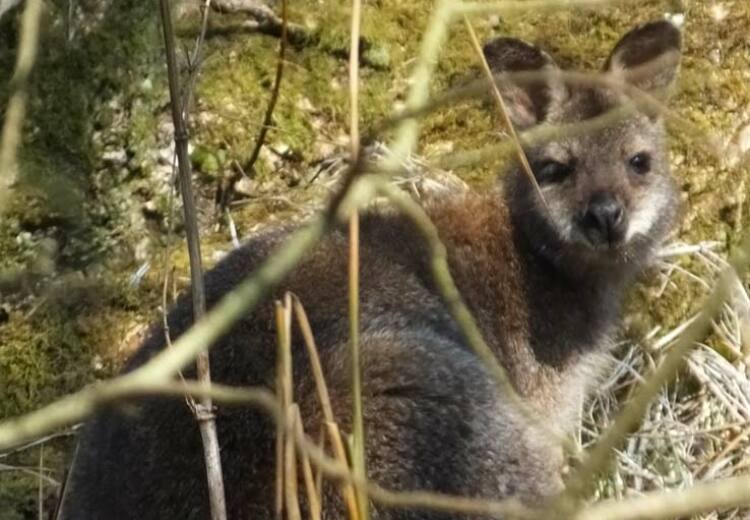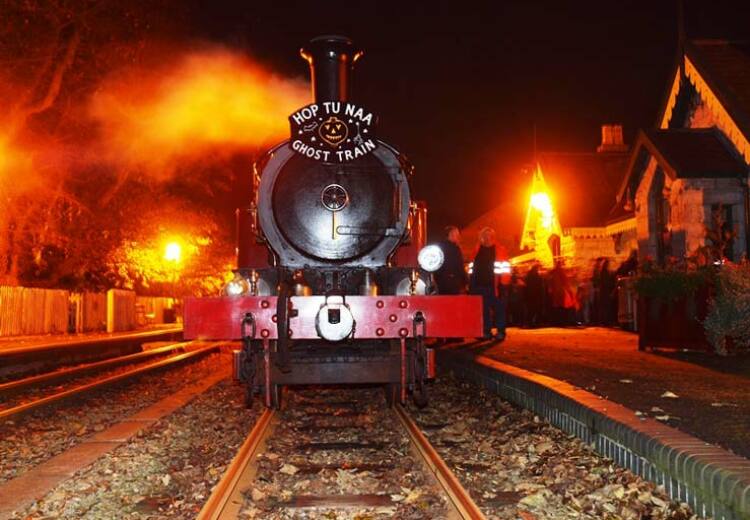
The Isle of Man hosts many traditional ceremonies throughout the year. View all annual events by month below.
View by Month
Jan • Feb • Mar • Apr • May • Jun • Jul • Aug • Sep • Oct • Nov • Dec
Or
Find Upcoming Local Events
JANUARY
January 01 - New Year's Day
This was often called Little Christmas. Fiddlers would go from house to house to rouse the occupants with music, and their wives would follow the next day for payment, usually food or drink. The English tune 'The Hunt is Up' was a favourite.
January o4 - Old Christmas Eve
On Old Christmas Eve, spinners stopped work until 6th January.
January 05 - Twelfth Night, Epiphany Eve, Old Christmas Eve, Wassail Eve
This was Old Christmas Eve in times past, and many people stuck to it long after the calendar change. It was customary to grow Sweet Cicely in Manx gardens, an aromatic plant called 'Myrrh', which tastes and smells of aniseed. At midnight people went outside with lanterns to see if shoots had appeared and if any had bloomed. The flowers open for an hour only.
January 06 - Twelfth Day, Epiphany, Old Christmas Day, Uphalieday
This was the last day of Yule. Fire was never borrowed today, but purchased instead. The herring fishermen's Boat Supper was sometimes held on this day. Wells were often visited, possibly encouraged by the Church to distract people from pagan practices associated with the last day of Saturnalia.
The ceremony of Cutting Off the Fiddler's Head was a Twelfth Day tradition carried out at dances at which the fiddler played. His other function was as a matchmaker. He would lay his head in a girl's lap and someone would ask him who such-and-such a girl shall marry - giving the name of a local girl present. The fiddler's answer was greeted accordingly by those in the know, with mirth, tears, anger or happiness.
A game similar to pairing valentines was played. A master of ceremonies (mainshter) was elected and he appointed a girl (legad) for every boy as their partner. The boy bought food and drink for the legad. Then the White Mare (laare vane) came in (with its wooden horse-head, snapping mouth and covered in a sheet; cf. the Welsh Mari Lwyd) and much merriment ensued.
Another game was Goggins or Noggins. Goggins are symbols of trades, such as water for a sailor, grain for a farmer, etc and are put into mugs on the end of the hearth. Girls are blindfolded and must choose a mug. The symbol in it is that of the proffession of their future husband.
January 07, 11, 12 - St Brannoc's Day, Old St Stephen's Day
When some herring fishermen held their Boat Supper.
January 31 - St Bride's (Bidget's, Brigid's) Eve
This evening is called Laa's Breeshey. Householders sttood outside their doors with armfuls of rushes and chanted an invitation to Bride to come in and bless the household, to bring luck and fertility. The rushes were strewn on the floor to make a bed for her, and a candle would be kept lit by food and drink left for her.
FEBRUARY
February 01 - Candlemas Day (The Presentation of Christ, Feast of Purification)
The Church tried to transfer festivities from the 1st to the 2nd to eliminate the memory of Bride. Hence many customs are the same on the two days.
By Candlemas, which was regarded as the middle of winter, half the stores of fodder and fuel laid down should remain.
February 13 - Old St Bride's Day
Kirk Bride Fair was held (formerly 1st February).
MARCH
Shrove Tuesday
Sollaghyn or 'crowdy' (a type of porridge) was eaten for dinner, instead of at breakfast, and meat for supper followed by a large pudding, and pancakes containing divination tokens.
School children barred-out their teachers today, crying 'Bear, bear (bar), give us holly (holiday)!'.
Periwinkle Fair was held today until 1834, at Pooil Vaaish, near Balladoole estate, an area with a long tradition of catching and eating shellfish, but it does, of course, fit in with Lenten practice.
Lent
Normal fasting rules were observed.
Ash Wednesday
Baldwin Fair was held today at Keeil Abbane, now St Luke's Chapel, until 1834. Kirk Marown Fair was held near the ruins of Keeil Pharick (St Patrick's Chapel) on the quarterland of Ballafreer. Also held today was Kirk Conchan (or Onchan) Fair, until 1834.
March 16 - St Abban's Day
St Abban's day is not celebrated as such for it refers to an ancient site called Keeil Abbane (Abban's Church), almost certainly pre-Norse and pre-Christian.
The Parliament for the south of the Isle of Man was near Keeil Abbane in the 15th Century, and that for the north was at Crork-Urley. They were subsequently merged into the Tynwald held at St john's for the whole island.
March 28 - Old St Patrick's Day
St Patrick's Day Fair was held at Peel. This was a day to hire female servants at the fair, and they started work on 12th May. The fair ceased after 1872.
MARCH or APRIL (depending on Year)
Good Friday
Generally commemmorated as elsewhere. No iron was put into the fire, nor tongs. A rowan stick was used instead. The griddle was also removed from the fireplace. A large soddag (bannock) was made, with three corners, and baked on the hearth. No ironing was done. Flitter (limpets) were eaten for breakfast, eggs and fish for dinner.
Easter Sunday
This was thought an unlucky day. Many stayed inside for fear of accidents. Daffodils, whose Manx name meant goose-herb, were not brought into the house while geese were hatching as this brought bad luck. If the mother goose saw the daffodils, she might look at the yellow colour of the flowers and think all her goslings had hatched, deserting the nest. Similarly, chickens hatching at Easter were a sign of bad luck.
Easter Monday
Tithes were paid to the Minister and Proctor this day or the next.
Easter Tuesday
Tithes were paid to the Minister and Proctor if not paid the previous day.
APRIL
April 01 - April Fool's Day
A peculiarly Manx trick was to tell a farmer that you had seen a tarroo-ushtey (a water-bull - a mythical beast dreaded for its capacity to cause chaos and mischief) in his field.
April 05 - St Derfel's Day, Old Lady Day
Jurby Fair, a hiring fair for female servants, was held.
April 23 - St George's Day
This day is not celebrated as St George's Day on the Isle of Man but there was a St George's Day Fair at Ballacleator Gate, Andreas, from 1813 until 1834. It was possibly instituted on this day as a compliment to King George III.
April 25 - St Mark's Day
After the first stroke of midnight ash, chaff will be born in the house, but if a footprint appears in the morning and faces inwards then a child will be born in the house, but if the footprint points outwards then a death will occur in the household.
St Mark's Day Fair was held at Ballasalla, and one at Ballavarkish, Bridge on the old calendar.
April 30 - May Day Eve, Beltane, Walpurgis Night
Gorse was burned on these high places, dollans (skin drums) were beaten and horns were blown through the night to scare away any witches. No one gave fire today. The fires were sited so that the prevailing winds carried smoke ove cornfields, cattle houses and dwellings for their purification, or the animals were driven through it. Housefires were put out and rekindled with a piece from one of these sacred fires.
Rowan (cuirn) crosses were made called Crosh Cuirn by breaking rowan twigs (not cutting with anything made of iron) and binding them with sheep wool. The crosses were hung from front doors to protect the occupants from witches, evil spirits and other malevolent forces. They were also attached to cattle, hiding them in the long hair of the tail.
The well Chibbyr Baltane (Beltaine Well) is on the moorside at Surby. Elderflower wine was traditionally made today.
Ascension Day (Fortieth day after Easter, Thursday before Whit Sunday)
Meat was eaten today, and wells visited.
MAY
May Day
This was St Philip's and St James's Day, though all celebrations were of pagan origin.
The battle of summer against winter is a theme in some May Day customs. When a Queen of the May was elected, attended by maids of honour and a boy as captain, a Queen of Winter was also elected in opposition to her. This was a man in women's clothes, with a similarly dressed entourage. The Queen of the May walked in procession with violins and flutes playing, while the Queen of Winter was accompanied by the clatter of tongs and cleavers. They met and engaged in mock battle. If the Queen of Winter won, then the Queen of the May was ransomed. Then the Queen of Winter retired and everyone feasted.
Beltane Fair was held at St John's, at least until 1872. There was also a Beltane Fair at St Patrick's Well in Kirk Lonan until 1834.
On this day people would also set off for the turf grounds to begin cutting the year's supply of fuel. They took as sustenance a thick gruel called Cowree.
May 11 - Old May Day Eve
As many on the Island resolutely stuck to the old calendar, Beltane rituals were performed today.
May 12
Servants hired on 28th March started work today. This was also a day for letting of houses, paying half-yearly rents and taking in grazing cattle for a fee.
There are records kept of sheep, horses, calves and cocks being sacrificed on this day for the prosperity of the rest.
Old May Day Fair was held at St Mark's, Kirk Malew, and a similarly names fair at St Patrick's Well, Lonan.
May 18
This day was connected with the Hospitallers, or Order of St John of Jerusalem, and was called the Summer Feast Date of Hospices (Hospitals), on which the Spitlhin Souree Fair was held at St John's. It was discontinued at the end of the 19th Century.
Tuesday after Trinity Sunday
A fair was held at Lezayre, and one at Sulby.
JUNE
June 04 - St Petroc's Day
Trinity Fair at Sulby was held.
June 08 - St Columba's Eve
In the 16th century the King's Forester climbed the highest hill on the island, sounded his horn three times, and repeated the forest laws. He then inspected the husbandry on the farms three days later and took any appropriate action. Stray animals were marked and sold.
June 11 - St Barnabas' Day, Feast Day
Another name for this day was The Summer Feast Day of the Cross. Before 1748 the King's Forester could mark stray sheep and other animals on this day and then sell them afterwards. After 1748 the key date was 21st June.
June 21 - Summer Solstice
After 1748 The King's Forester could mark stray sheep and other animals and then sell them.
June 23 - Midsummer Eve, St John's Eve
It was the custom to hang rowan crosses up.
June 24 - Midsummer Day, St John's Day, Nativity of St John the Baptist
At Barrule, well into the 19th century, bundles of grass were laid down for the Celtic God of Man & Arran, Manniman-beg-mac-y-Lear, who appeared as a heron and would be seeking women to court.
This was John the Baptist's Feast Day or Little Trinity. Midsummer Fair (or Little Trinity Fair) was held at Sulby Claddaghs, Lezayre.
June 30
This was the last day of peat digging, by law, in public turbaries.
JULY
Peel Longboat Races
In July, the Viking Longboat Races at Peel replace the now defunct, but much larger, Viking Festival, the date depending on the tides.
July 4 - Old Midsummer Eve, St Martin o' Ballymus' Day, Bullion Day
Rituals were as on Midsummer Eve. The height of the next harvest was determined by how high men could jump over the flames.
People sat up all night to watch, some in church porches in order to see the souls of those who would die that year - as on St Mark's Eve and Hollantide Eve.
July 5 - Old Midsummer Day, St Morwenne's Day
Cheese-making was done on Old St John's Day for Harvest Home and rain wished for. Bonfires were lit on hills and blazing cartwheels rolled down, to typify the sun's decline.
Jul 05/06 - Tynwald (Isle of Man Parliament) Ceremony, Tynwald Hill, St John's
This takes place on 5th July or, if that is a Saturday or Sunday, on the following Monday. Dating back to Viking times, the Tynwald preserves the Old Norse custom of publicity announcing all new laws, in both Manx and English. The promulgation of new laws in Manx and English is necessary before they can be enforced. In the distant past the Tyn (from the Old Norse 'Thing' meaning public assembly) was also the place to settle disputes, so it was both parliament and court. One reason to hold it on this day was that all evil influences had been driven out the previous evening.
Tynwald Fair is also held today, which was a public holiday. If the 5th July is a Sunday, then both are hold the next day. Tynwald Hill is between Douglas and Peel, but in former times there were assemblies for the North and South regions of the island. Tynwald Hill for the South was at Keeil Abban (now St Luke's Chapel), and that for the North was at Reneurling (now Cronk Urley or Urleigh).
The Tynwald is the last of a four-stage process of law creation. First, the laws are decided by the legislature in Douglas, formerly at Castle Rushen, Castletown. This body is called the Keys (from Old Norse 'kuid' meaning jury) and its members aer chosen by popular vote. Second, the laws go to the Council for further scrutiny, and, third, to the monarch for ratification. Only then are they promulgated next Midsummer Day.
On the green at St John's the Tynwald Fair, following the Norwegian custom of holding a fair when the Parliament (Thing) was in session, has stalls, shies, bands, dancers and other entertainments. A speciality sold is home-made Tynwald Fudge.
July 13 - St German's Day
This is St German's Day. He was a former, some say the first, Bishop of Man, in AD447. Tynwald Hill is in the parish of St German.
July 16
By a law passed in 1610, herring fishing began today. Later on it started much earlier.
July 31 - St Neot's Day, Lammas Eve
This is Maughold's Feast Day of Summer, his first feast day, the other being on 26th November (or 15th). Maughold, or Machutus, has many legends attached to him. He is said to have been a former Bishop of Man, but his existance cannot be proved. There may have once been a St Maughold's Fair at Ramsey today.
AUGUST
August 01 - Lammas
The Feast of Lugh or Luan (Luanys's Day), the corn god, was on this day. Legend has it that Lugh spent his boyhood on the Isle of Man as Mannanan's foster son. Lugh and Crom Dubh battled for the personification of corn in a woman (called in Gaelic Eithne - grain or kernel). There was once a great fair in his honour in Santon parish. Visiting high hills and sacred wells on this day was done in ancient times to scare withches away as it was considered Midsummer Day. Moreover, harvest was seen as the climax of the year by farmers, who would also take the opporunity from on high to view their land with thankfulness, pride and not a little relief. The Church tried to eradicate the profane activities by changing the date to the first Sunday in August, replacing Lugh by St Patrick and substituting bible readings about Jephtha's daughter (replacing Eithne) and her companions going up the mountains to bewail her virginity, The Church also referred to it as the first Sunday of Harvest and steered the celebrations accordingly. In some cases the tradition degenerated to an outing to pick blueberries.
The time between now and Old Lammas on the 12th August was the favoured time to cure herrings.
First Sunday in August.
This was one of the most important days for visiting wells, particularly St Catherine's Well, Port Erin; ChibbyrParick or Pherick (St Patrick's Well) on the west end of the hill of Lhargey-grave; Chibbyr Pherick south of Peel; the well at Maughold Head; Lord Henry's Well on the south beach at Laxey; and the nunnery Well in Braddan parish.
August 05 - Old St James' Day
Laxey Fair was held. Originally it was on 2nd August, and called St Lonan's Fair because it was in Kirk Lonan parish.
August 12
Old Lammas Ballasalla Fair (or Lammas Fair) was held until the end of the 19th century
First Sunday after Old Lammas
This was Lhuany's Day, the day of a festival dedicated to the god Lugh. An orgy was held at the top of Snaefell.
The water in healing wells is said to be particularly potent today, and in the past they were much visited. St Maughold's Well, near Ramsey, is said to cure sterility; either by immersion in it or by dropping a pin into it.
Harvest Customs
A young woman reaper would ceremonially cut the last corn and bind it with wild flowers and ribbon into a 'babban ny mhellea' or harvest baby, which was thought to contain the corn spirit. This tradition may have come from England, adopted principally in the wheat areas of Castletown and beyond Ramsey. Crofters, cutting their oats and barley, are not known to have done it. After supper a fiddler played for dancing. he prettiest girl was given a bouquet of wild flowers and called the Queen of the Mheillea, or a smaller sheaf called the 'harvest doll', was kept all year on the chimney-piece in the kitchen. Another variation was the taking of the Mheillea by the women reapers to the top of a hill where the celebrations and feast were held in the open. A traditional harvest dish was Manx Herring Pie.
On the first Sunday after the harvest a Harvest Thanksgiving service would be held.
One of the crafts which was done after the harvest, when there was a little time to relax, was rush-plaiting, used to make toys for the children.
SEPTEMBER
September 29 - Michaelmas Day, St Michael's Day, Feast of St Michael and All Angels
Kirk Michael village and parish was named after this saint. There used to be a great market today in Douglas, and a fair at Ballasalla. A roast goose dish such as Manx Michaelmas Goose with Apple Sauce was eaten.
OCTOBER
October 01
All peat stacked in public turbaries had to be removed by this date.
October 10 - Old Michaelmas Day
Kirk Michael Fair was held, originally at Michaelmas, and was still in existence in 1941. It was a hiring fair for farm labourers. A traditional way to preserve the last of the black-berries was to make Blackberry Wine.
October 31 - Hop Tu Naa, Hallowe'en, All Hallows' Eve, All Saints' Eve, Hollantide Eve
Effectively, winter and Savin, the start of the Celtic New Year, began this evening. Savin was also called Hop Tu Naa ('This is the Night'), the same as the New Year Feast. Hollantide Eve was also called Hogmanaye night. Animals that could not be kept through the winter would be slaughtered and salted down. It was customary for children to go round with turnip lanterns, singing 'Oie Houney' and collecting money. There was much prophesying, weather prediction and fortune-telling, customs that gradually were transferred to Christmas and the New Year in January.
The traditional supper this evening is potatoes, parsnips and fish pounded together with butter. Children carried turnip lanterns from house to house, asking for bonnags (oatcakes).
NOVEMBER
November 01 - All Saint's Day, All Hallow's Day, Hollantide Day, All Souls' Eve, St Cadfan's Day
Mummers went round on this day used to begin their play by saying 'Tonight is New Year's Night, Th Moon shines Fair and Bright.' This comes from an Old Hollantide Eve (11th November) rhyme chanted by boys as they went from house to house whacking the door with a cudgel and running off. In some areas boys carried sticks with cabbages or turnips stuck in the top and knocked with these to ask for herrings, potatoes or other gifts.
Hollantide Fair was held at St John's until the end of the 19th century and was an important hiring fair. Land and property was let or leased today, and rents fell due.
November 11 -Martinmas, St Martin's Day, Old Hollantide Eve
Hollantide Eve today was known as Hop-tu-Naa. Mummers went from door to door, knocking on them with turnips or cabbages on sticks and singing the Hop-tu-Naa song which transferred to 31st October. The traditional supper was potatoes, parsnips and fish mashed with butter, The remains, with crocks of fresh water, were left for the faeries. Marriage divination was practised by unmarried girls.
November 12 - Old Hollantide Day, Old Samhain
This was the traditional day for letting land, paying rent and hiring men-servants for the year. Hollantide customs were generally observed on this day even after the calendar change, including the bringing in of cattle for housing or slaughter for the winter.
Hop-tu-naa processions still occur, either early in the morning or on the previous evening, though some have moved to 31st October. Children with turnip lanterns go from door to door asking for contributions. This originally served as a way to bless every household and with it free from ill luck throughout the year, this being the end of the Old Celtic Year.
Hollantide Fair was held at Douglas and as well at other places, a speciality sold was Hollantide Fairings.
November 18
This was the Winter Feast Day of Hospices (Hospitals), six months after the Summer Feast Day of Hospices on 18th May. As on that day a fair was held at St John's until 1834.
November 26
This is Maughold's Feast Day of Winter, his second fest day, the first being 31st July. Most of Ramsey lies within the old parish of Maughold, and the second St Maughold Fair was held there.
DECEMBER
December 06 - St Nicholas' Day
This was the old feast day of St Catherine. On the south side of the island new occupiers of land had to take possession of it on this day.
Colby Fair at Colby in the parish of Arbory was held today, starting with a procession that featured the display of a live hen, called St Catherine's Hen. The next day the hen was paraded dead and plucked, and a rhyme chanted: 'Catherine's hen is dead; The head take thou, and I the feet, And we shall put her under ground.'
There is an old custom that people settled differences on St Catherine's Day by plucking feathers and burying them, and this may relate to this. Another story says that Kathering, heiress of Colby Mooar, gave the land for the fair on St Catherine's Day as St Catherine's Church was on her estate. Moreover, she gave a hen to be killed and eaten, and ale to be drunk, at a village feast. One hen for a village feast is scarcely the height of generosity!
December 11 - Old St Andrew's Day
On the north side of the island new occupiers of land had to take possession of it today.
Andreas fair was held today.
December 20 - St Thomas' Eve, Fingan's Eve
Although the origin is unclear, it is said that people used to cut a great turf of peat on this evening. Perhaps this is a Manx equivalent of the Norse Yule Log.
December 21 - St Thomas' Day, Midwinter Dat, Winter Solstice, Fingan's Day
St Fingan's Fair was held in Ramsey until 1834. Keeill Ingan, a church dedicated to St Fingan, was in Kirk Christ Lezayre, near Ramsey. The estate name Ballakillingam preserves the name, and was formerly the site of the fair.
Saturday before Christmas - White Boys' Mumming Plays, Douglas, Peel, and Ramsey
These were revived in the 1970s, and unusually take place between 10am and 5pm. The general theme is that St Denis kills St George, who in turn is killed by St Patrick. The Doctor then brings them back to life, and askes the audience for his fee - which they contribute. A sword dance concludes the proceedings.
December 24 - Christmas Eve
Today was known as the Eve of Mary's Feast Day.
The traditional Christmas Eve service was the Oie'l Voirrey, which, with its Carval-singing, was attacked by the Methodists bbut never completely suppressed. The parish church was lit with candles, and each parishioner took their own candle. The church was decorated with ivy and holly ('hibbin as hollan'. After a prayer and hymn the parson would go home, leaving the parish clerk to direct the singing of the Carvals. Carvals were religious poems of parishioners' own composition. The golden age of Carval writing was the 18th century, but some are older, some newer. Themes may be on the nativity; the life of Christ; sin and repentance; death, judgement and the torments of hell; or on biblical events, especially if of a moral character.
Starting at the west end of the church, opposite the altar, the singer (or pair doing alternate verses), with Carval book and candle, would sing as he/she advanced slowly, timing the step to finish just before it. It could be that most adults would want to sing, and this made the service very long. Afterwards the mood lightened and unmarried girls would throw parched peas at bachelor friends, a custom that often became disorderly. Then, all would adjourn to a house or ale-house to drink ale spiced with pepper. Before retiring, the Arrane Oie-Vie (The Good Night Song) would be sung.
Eventually the Oie'l Voirrey was stripped of its carvals, pea-shooting and ale-drinking, and in this modified form was held in Methodist chapels. It has survived in unbroken tradition only in Kerrowkeil chapel, but has been revived elsewhere.
Visitors to the house were treated like New Year's Day first-footers. Farmers and fishermen gathered at public houses for a jough-vie (good ale). Every house lit a big Christmas candle and merry-making continued until it was burned out. The traditional drink was hot ale with spice, ginger and pepper.
During Christmas
At Christmas, dances in barns to a fiddler were popular, and thoughts turned to matchmaking. Christmas mummers, the White Boys, and the Mollag Band gave performances at Christmas. They were purveyors of good luck and prosperity like the feathers of the wren.
December 25 - Christmas Day
Hunting the wren involves thrashing the hedges with sticks to flush it out for capture and killing, but in living memory the bird was not killed. The last verifiable killing was in the 19th century, but the hunt was still active in the 1930s, surviving today only at Peel. No work was done between today and the 6th January (Old Christmas Day). Goose pie was a traditional dish.
The White Boys at Christmastide went round houses performing the mumming play of St George and the Dragon. This had characters like St George, Prince Valentine, King of Egypt, Sambo and the Doctor. The Doctor, with bladder-stick and collecting box, injected amusement.
Another scene to be witnessed in the past was the sight of young boys with blackened faces, dressed in women's white caps and aprons, going around dancing and singing.
December 26 - Boxing Day, St Stephen's Day
The Wren Boy who killed the wren was praised, made King for the day, and assured of good luck in the coming year. In early times, the wren was plucked, laid on a bier with great solemnity, taken to the parish church, and buried. Dirges were sung over the grave in Manx. Later, another way of parading the dead bird was adopted, to suspend it from two wooden hoops, crossed at right angles, fixed on the end of a pole decorated with evergreens and coloured streamers. This was paraded with drums beating and flags flying in a triumphal procession. The feathers were distributed as charms against evil influences and hazards in the new year. These were mcuh sought after by herring fishermen. A wren-song, 'The Hunting of the Wren' was sung when the pole was set up outside a house on the processional route. Still more recently the ceremonial was held, in Peel, but the wren was not actually killed. Nowadays a live bird is not used and the garlanded wren-pole have a model bird.
December 31 - New Year's Eve, St Sylvester's Day, Oie Houney
This day was also called Little Christmas Eve.
Oie Houney was the last night before Laa Houney (New Year's Day) and the season of Sauin (Samhain to the Irish and Samhiunn to the Scots), which marked the beginning of winter. It was originally November 12th, before being changed to November 1st on the new calendar. It was a significant time for the Manx farmers: rents were due, lands and property were leased and, as the weather grew harsher, livestock were brought in from the fields and sheltered until the spring, or, as was the case in earlier times, slaughtered out of necessity.
This was also a great time for divination and prophesying. If a maiden wanted to learn who was to be her future husband, she baked a Soddag Valloo or 'dumb cake', so called because it was baked and eaten in silence. It was thought that eating the cake, and then walking backwards to bed, would ensure a dream of the husband-to-be. Alternatively, the girl should steam a neighbour's salt herring, roast it in the fire and eat it in silence.
If a household wanted to determine their fortunes for the coming year, they had to smooth ashes from the fire around the hearth area before retiring to bed. In the morning, they would look for a footprint in the ashes: if it faced inwards, a birth could be expected; if it faced the door, there would be a death in the house.







